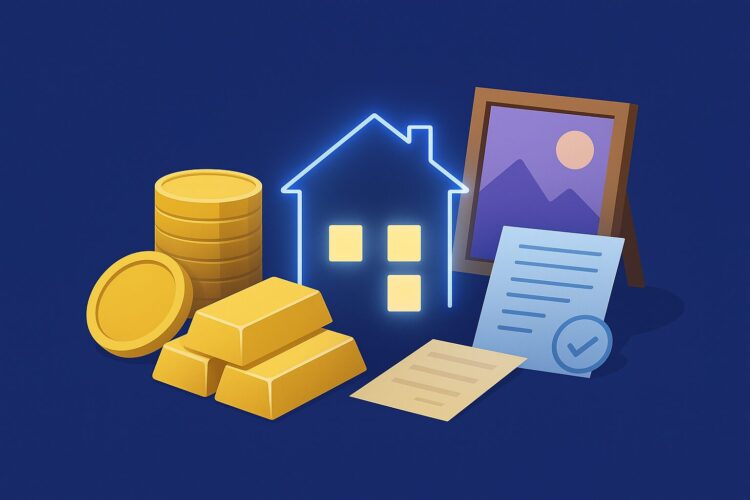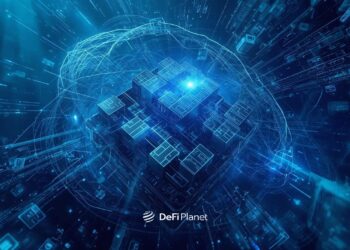A few years ago, talking about putting real estate or government bonds on the blockchain felt like wishful thinking. DeFi was mostly focused on digital assets like crypto tokens, while traditional finance stuck to its usual ways — slow processes, middlemen, and systems that hadn’t changed in decades.
But things are changing.
Today, we’re seeing a growing interest in real-world asset tokenization; sometimes referred to as tokenization of real-world assets. This isn’t just some theory being passed around in RWA crypto circles. Big names like BlackRock, Franklin Templeton, and JPMorgan are already experimenting with or offering tokenized versions of real-world assets. This is evidence that the tokenization of real-world assets is shifting from concept to mainstream financial strategy.
The market for asset-backed tokens such as tokenized U.S. Treasuries alone has grown past $1.5 billion. As of mid-2025, the market for tokenized real-world assets (excluding stablecoins) has surpassed $15 billion, growing over 85% year-over-year, and that’s just the beginning. In fact, several RWA crypto projects are now building infrastructure to make it easier for both retail and institutional investors to gain exposure to these assets.
So, what does all this mean for the future of finance? Could bringing real-world value onto the blockchain help DeFi adoption grow beyond niche users and go mainstream?
Let’s go a bit deeper into how real-world asset tokenization is making that possible—and why it matters now more than ever.
What Are Real-World Assets (RWAs) — And Why Tokenize Them?
If you’re new to the Real-world asset tokenization space, let’s do a quick crash course. When you hear the term real-world assets, think of things you can touch, use, or traditionally invest in. Basically, things that exist outside the crypto space. We’re talking about assets like houses, land, gold, company shares, invoices, or government bonds. These are the same kinds of assets people have used to build wealth for generations.
In the blockchain world, the tokenization of real-world assets simply means creating a digital version of that asset, a token that lives on a blockchain and represents ownership, value, or rights to the real thing.
For example, imagine you own a house worth $200,000. Normally, if you wanted to raise money from it, you’d need to go through a lengthy mortgage process, pay lawyers, and involve banks. But with fractional asset ownership enabled by tokenization, you could create 200,000 digital tokens, each representing a $1 share of the house. These tokens could be sold, traded, or used as collateral on a DeFi innovation platform, all without traditional middlemen.
This is a big deal because it makes valuable assets more accessible, liquid, and usable in new ways. Investors can now:
- Buy a fraction of a high-value asset (like real estate) without huge capital.
- Trade traditionally illiquid assets instantly.
- Use these assets in Institutional DeFi protocols for lending, borrowing, staking, or restaking, just like they would with crypto.
In short, tokenization of real-world assets unlocks value that used to be stuck in offline systems and brings it into the open, programmable world of blockchain. As more markets tap into the tokenization of real-world assets, the potential for global liquidity and cross-border investment grows exponentially.
Why Real-World Asset Tokenization Could Be a Game Changer for DeFi
DeFi has come a long way. From experimental lending protocols to billion-dollar ecosystems. But most DeFi vs TradFi comparisons reveal a gap: DeFi activity still largely revolves around crypto-native assets, which means price volatility, limited real-world use, and high risk for the average user.
This is where real-world asset tokenization changes the equation. By introducing stable, income-generating asset-backed tokens into the ecosystem, DeFi gains:
- Stability: Tokenized RWAs like U.S. Treasuries offer predictable yields.
- Utility: These assets can be used as collateral or for structured products in Institutional DeFi.
- Credibility: Real-world value backing DeFi helps attract mainstream trust.
How Real-World Asset Tokenization Backs Defi
- Stability: Tokenized RWAs like U.S. Treasuries offer predictable yields.
- Utility: These assets can be used as collateral or for structured products in Institutional DeFi.
- Credibility: Real-world value backing DeFi helps attract mainstream trust.
Projects like Ondo Finance and Maple are already enabling institutional-grade yields from tokenized bonds and private credit markets all onchain. This is what DeFi adoption looks like, powered by real-world assets and reinforced by growing RWA crypto infrastructure.
Real-World Examples — Institutions and Protocols Leading the Way
What makes tokenization of real-world assets more than theory is the fact that it’s already being embraced by both Wall Street and RWA crypto pioneers:
Institutions and Protocols Leading the Way in RWA Tokenization
- BlackRock — launched a tokenized Treasury fund on Ethereum.
- Franklin Templeton — operates a tokenized money market fund on Stellar and Polygon.
- JPMorgan — uses its Onyx platform for tokenized bonds and cross-border settlements.
- Crypto-native protocols — Centrifuge, Goldfinch, Maple, and Ondo Finance are leading DeFi innovation with tokenized private credit and real estate debt.
Could DeFi Really Outpace TradFi with Tokenized Assets?
The idea of DeFi surpassing TradFi has been floating around for a few years now, but real-world asset tokenization is starting to give that vision a sharper, more tangible edge.
Think about it: by bringing assets like real estate, commodities, government bonds, and even fine art onto blockchain networks, DeFi platforms can offer access to stable, yield-generating instruments without all the friction and middlemen that slow down TradFi systems. This isn’t just about copying TradFi onchain; it’s about reimagining how these assets are accessed, traded, and used as collateral in a global, 24/7 marketplace.
In TradFi, getting into many lucrative asset classes feels like trying to get past a locked gate. Minimum investment thresholds, geographic restrictions, and long settlement times make it tough for everyday investors to participate. Tokenization of real-world assets changes that by enabling fractional asset ownership turning, say, a multi-million-dollar property into tokens worth just a few dollars each. Suddenly, it’s not only high-net-worth investors who get a seat at the table. Small-scale investors around the world can tap into opportunities that were once out of reach.
Efficiency is another place where DeFi could sprint ahead. TradFi still leans on clearinghouses, custodians, and other middlemen to process transactions, a system that can take days and drive up costs. In contrast, RWA crypto can be issued, transferred, and settled on-chain almost instantly, with transparent ownership records anyone can check. Smart contracts take care of the heavy lifting whether that’s distributing interest or liquidating collateral, cutting down on human error and overhead. The result? A leaner, faster financial system where value moves at internet speed.
Liquidity, which is often the Achilles’ heel of alternative investments, also plays out differently here. In TradFi, offloading part of your stake in a private equity fund or commercial property could take months, even years. Onchain marketplaces, on the other hand, can support peer-to-peer trading of asset-backed tokens in real time. That means investors can unlock liquidity from traditionally illiquid assets, making DeFi a much more attractive option for those who value speed and flexibility.
One of DeFi’s biggest game-changers, though, is composability: how protocols can plug into and build on each other’s products. Imagine a tokenized Treasury bond. In DeFi, you could use it as collateral in a lending protocol, stake it for yield, or swap it for stablecoins on a decentralized exchange, all without ever leaving the blockchain. In TradFi, moving that same asset between these uses would mean dealing with multiple intermediaries, endless compliance checks, and frustrating delays.
And then there’s the global reach. DeFi’s permissionless nature sidesteps the geographical silos that TradFi operates in. An investor in Nigeria could buy a token representing a share in a New York office tower. At the same time, an entrepreneur in Argentina could raise capital from supporters across Asia and Europe with no brokers, no correspondent banks, no currency headaches. That level of inclusivity could tilt the scales in DeFi’s favour, especially in emerging markets hungry for alternatives to dollar-dominated systems.
Of course, this isn’t just about the tech it’s about trust. Blockchain’s immutable ledger, combined with programmable smart contracts, can deliver transparency even the most regulated TradFi markets struggle to match. Every transaction, every change in ownership, every yield payout; it’s all recorded publicly, making shady accounting and hidden fees harder to pull off. For a generation increasingly sceptical of traditional institutions, that openness is a big deal.
The catch? DeFi still needs to solve for scalability, user experience, and legal clarity before it can truly hit its stride. But when you look at speed, accessibility, interoperability, and transparency, tokenized assets give DeFi tools that TradFi simply can’t match in its current form.
If adoption keeps growing, both retail-focused platforms and Institutional DeFi could see this RWA-powered ecosystem shift from an intriguing side project to the main stage of asset exchange—where tokenized instruments are the default, not the exception. The real question then won’t be “Can DeFi outpace TradFi?” but “How fast can TradFi adapt before it’s left behind?”
Looking Ahead: The Roadblocks and the Roadmap for DeFi
As promising as RWA tokenization is, it’s not a guaranteed win for DeFi just yet. Several hurdles stand between where we are now and a fully integrated decentralized financial system built on tokenized real-world assets. Let’s take a look at some of these hurdles:
- Regulatory Uncertainty: The biggest elephant in the room is regulation. Governments and financial watchdogs around the world are still figuring out how to classify tokenized assets. Are they securities? Commodities? Something entirely new?
For example, in the U.S., the SEC has already taken action against some crypto projects that resemble traditional investment vehicles. This regulatory fog slows down institutional involvement, especially when large players want clarity before committing billions.
- Infrastructure Gaps: While DeFi is growing fast, it’s still early. There are gaps in custodial services, insurance, user-friendly interfaces, and reliable oracles — all critical for bridging real-world assets into the blockchain economy securely and efficiently.
Also, many DeFi platforms still lack full interoperability with real-world legal and financial systems. For instance, tokenizing a building is one thing; enforcing ownership rights in court is another.
- User Education and Trust: Most people still struggle to understand the basics of crypto, let alone the concept of tokenized real estate or yield-bearing NFTs backed by carbon credits. Building trust will require clear communication, better design, and real-world use cases that prove lasting value.
Until then, many will view DeFi as a risky playground rather than a serious competitor to traditional banking.
The Bottom Line: This Could Still be DeFi’s Big Opportunity
Despite the challenges, the momentum is real. The tokenization of real-world assets is one of the most tangible ways to bridge the gap between DeFi and TradFi. It has the potential to unlock trillions of dollars in global assets and deliver a more open, transparent, and efficient financial system.
It’s no longer about whether real-world asset tokenization is coming—it’s about how fast it’s coming, who’s ready, and which platforms will lead the charge.
As both retail investors and institutions wake up to the potential, we could be witnessing the early stages of a financial revolution—one tokenized building, bond, or barrel of oil at a time.
Disclaimer: This article is intended solely for informational purposes and should not be considered trading or investment advice. Nothing herein should be construed as financial, legal, or tax advice. Trading or investing in cryptocurrencies carries a considerable risk of financial loss. Always conduct due diligence.
If you would like to read more articles like this, visit DeFi Planet and follow us on Twitter, LinkedIn, Facebook, Instagram, and CoinMarketCap Community.
Take control of your crypto portfolio with MARKETS PRO, DeFi Planet’s suite of analytics tools.”





















